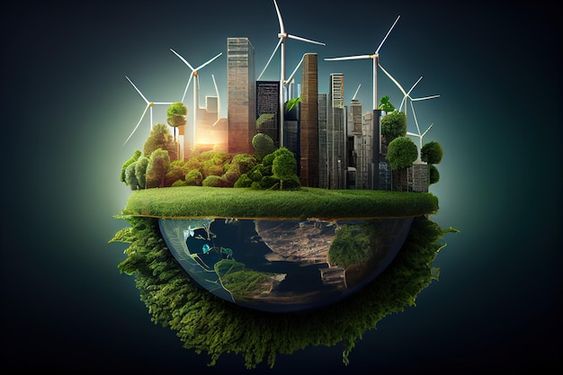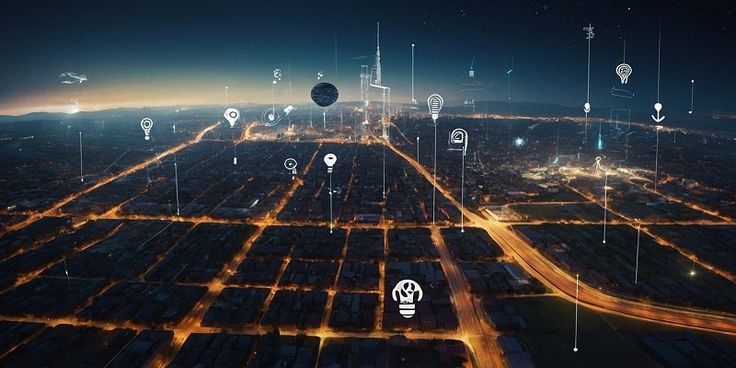Sustainable Technology: Innovations for a Greener Planet
As the world grapples with the escalating challenges of climate change, resource depletion, and environmental degradation, sustainable technology emerges as a beacon of hope. This approach aims to develop solutions that not only address current needs but also ensure a viable future for generations to come. Sustainable technology, or green technology, encompasses innovations designed to minimize environmental impact, conserve resources, and promote ecological balance. This article explores some of the most promising innovations in sustainable technology and how they are contributing to a greener planet.
1. Renewable Energy Innovations
Renewable energy is the cornerstone of sustainable technology, providing cleaner alternatives to fossil fuels that are vital for reducing greenhouse gas emissions. Key innovations in this area include:
- Solar Power Advancements: Solar energy has made significant strides, with innovations like perovskite solar cells offering higher efficiency at lower costs compared to traditional silicon-based cells. Solar panels are now being integrated into various surfaces, including roofs and windows, making solar energy more accessible and adaptable to different environments. Additionally, solar energy storage technologies, such as advanced batteries and thermal storage, are improving the reliability and continuous availability of solar power.
- Wind Energy Developments: Wind power continues to evolve with the development of larger, more efficient turbines that can capture more energy even in low-wind conditions. Offshore wind farms, particularly floating turbines, are unlocking new opportunities by harnessing wind energy over deeper waters where winds are stronger and more consistent. These innovations are crucial for expanding the adoption of wind energy in areas previously deemed unsuitable.
- Hydropower and Marine Energy: While hydropower has long been a reliable source of renewable energy, new developments focus on reducing its ecological impact. Run-of-river systems, which divert only a portion of a river’s flow, minimize disruption to aquatic ecosystems. Marine energy, including tidal and wave power, is an emerging field with the potential to generate substantial energy by harnessing the power of the oceans.
2. Energy Efficiency and Smart Technologies
Improving energy efficiency is another vital aspect of sustainable technology, helping to reduce energy consumption and emissions. Key innovations in this field include:
- Smart Grids: Smart grid technology enhances the efficiency and reliability of electricity distribution by integrating digital communication with the power grid. This allows for real-time monitoring, automated control, and the integration of renewable energy sources. Smart grids facilitate demand-response programs, where energy usage is adjusted based on availability, reducing waste and optimizing the overall energy system.
- Energy-Efficient Buildings: The construction and operation of buildings are significant contributors to global energy use and carbon emissions. Innovations in sustainable architecture, such as green building materials, passive solar design, and smart building systems, are making buildings more energy-efficient. Technologies like advanced insulation, energy-efficient lighting, and smart HVAC systems are reducing the energy needed for heating, cooling, and lighting, contributing to lower carbon footprints.
- IoT and Energy Management: The Internet of Things (IoT) is transforming energy management by enabling real-time monitoring and control of energy use in homes, buildings, and industries. Smart meters, connected appliances, and energy management systems allow for more efficient energy consumption, reducing waste and optimizing the use of renewable energy sources.
3. Sustainable Transportation
Transportation is a major contributor to global emissions, but sustainable technology is paving the way for cleaner, more efficient mobility solutions. Key innovations include:
- Electric Vehicles (EVs): Electric vehicles are at the forefront of sustainable transportation, with advancements in battery technology driving improvements in range, charging speed, and affordability. EVs produce zero tailpipe emissions and can be powered by renewable energy, making them a critical component of reducing transportation-related carbon emissions. The development of electric buses, trucks, and even airplanes is extending the benefits of electrification to all sectors of transportation.
- Shared Mobility and Autonomous Vehicles: Shared mobility services, such as ride-sharing and car-sharing, are reducing the number of vehicles on the road, leading to lower emissions and less traffic congestion. Autonomous vehicles, which are expected to be electric, could further enhance these benefits by optimizing driving efficiency and reducing energy consumption.
- Sustainable Fuels: For sectors where electrification is challenging, such as aviation and shipping, sustainable fuels offer a promising alternative. Biofuels, produced from organic waste, and synthetic fuels, created using renewable energy, can significantly reduce the carbon footprint of these industries.
4. Circular Economy and Sustainable Materials
The concept of a circular economy is gaining traction as a way to reduce waste and make the most of limited resources. Sustainable technology is driving innovations in materials and processes that support this shift:
- Recycling and Upcycling: Advances in recycling technology are making it possible to recover and reuse materials more efficiently. For example, chemical recycling processes can break down plastics into their basic components, which can then be used to create new products. Upcycling, where waste materials are transformed into products of higher value, is also gaining popularity as a sustainable alternative to traditional recycling.
- Biodegradable and Eco-Friendly Materials: Innovations in materials science are leading to the development of biodegradable plastics, sustainable packaging, and eco-friendly textiles. These materials break down more easily in the environment, reducing pollution and the burden on landfills. For instance, bioplastics made from plant-based materials are increasingly being used as an alternative to petroleum-based plastics.
- 3D Printing and Sustainable Manufacturing: 3D printing technology is revolutionizing manufacturing by reducing waste and enabling the production of complex, customized products on demand. This technology can significantly lower the environmental impact of manufacturing by minimizing material waste, reducing the need for transportation, and enabling the use of sustainable materials.
5. Sustainable Agriculture and Food Production
Agriculture is another critical area where sustainable technology is making a significant impact. Innovations aimed at reducing the environmental footprint of food production include:
- Precision Agriculture: Precision agriculture uses technology such as GPS, IoT sensors, and data analytics to optimize farming practices. This approach allows farmers to apply water, fertilizers, and pesticides more precisely, reducing waste and minimizing environmental impact. Drones and satellite imagery provide real-time data on crop health, soil conditions, and weather patterns, helping farmers make informed decisions.
- Vertical Farming and Controlled Environment Agriculture (CEA): Vertical farming and CEA involve growing crops in stacked layers or controlled environments, such as greenhouses. These methods use significantly less water and land than traditional farming, reduce the need for pesticides, and enable year-round production. Innovations in LED lighting, hydroponics, and aeroponics are making vertical farming more efficient and scalable, potentially transforming urban food production.
- Sustainable Aquaculture: Aquaculture, the farming of fish and other aquatic organisms, is becoming more sustainable through innovations such as recirculating aquaculture systems (RAS), which recycle water and reduce the environmental impact of fish farming. Additionally, integrated multi-trophic aquaculture (IMTA) combines the farming of different species in a way that mimics natural ecosystems, reducing waste and improving overall sustainability.
6. Water Conservation and Management
Water is a precious resource, and sustainable technology is helping to address the challenges of water scarcity and pollution:
- Water-Efficient Technologies: Innovations such as drip irrigation, low-flow fixtures, and water-efficient appliances are helping to reduce water consumption in agriculture, industry, and households. These technologies are crucial for conserving water in regions facing scarcity.
- Water Purification and Desalination: Access to clean water is a growing concern, especially in arid regions. Sustainable water purification technologies, such as solar-powered desalination and advanced filtration systems, are providing new ways to produce potable water from seawater and polluted sources. These innovations are essential for addressing the global water crisis and ensuring a sustainable supply of clean water.
- Wastewater Treatment and Recycling: Sustainable wastewater treatment technologies are enabling the recycling and reuse of water in industrial and agricultural processes. Techniques such as membrane bioreactors and constructed wetlands are improving the efficiency and effectiveness of wastewater treatment, reducing the impact on freshwater resources.
7. The Role of Policy and Collaboration
While technological innovation is critical, the widespread adoption of sustainable technology requires supportive policies and collaboration across sectors:
- Government Policies and Incentives: Governments play a crucial role in promoting sustainable technology through policies such as carbon pricing, subsidies for renewable energy, and regulations that encourage energy efficiency and waste reduction. These measures can accelerate the adoption of green technologies and create a favorable environment for innovation.
- Public-Private Partnerships: Collaboration between governments, businesses, and research institutions is essential for developing and scaling sustainable technologies. Public-private partnerships can provide the funding, resources, and expertise needed to bring innovative solutions to market and implement them on a large scale.
- Global Cooperation: Addressing global environmental challenges requires international cooperation. Initiatives such as the Paris Agreement on climate change and the United Nations Sustainable Development Goals (SDGs) provide frameworks for global action and encourage the sharing of technology and best practices across borders.
Conclusion
Sustainable technology represents a critical pathway to addressing the environmental challenges of the 21st century. From renewable energy and energy efficiency to sustainable transportation, materials, and agriculture, innovations in green technology are helping to create a more sustainable future. However, realizing the full potential of these technologies requires supportive policies, collaboration, and a commitment to sustainability from all sectors of society. By embracing sustainable technology, we can build a greener planet and ensure a healthier, more resilient future for generations to come.










